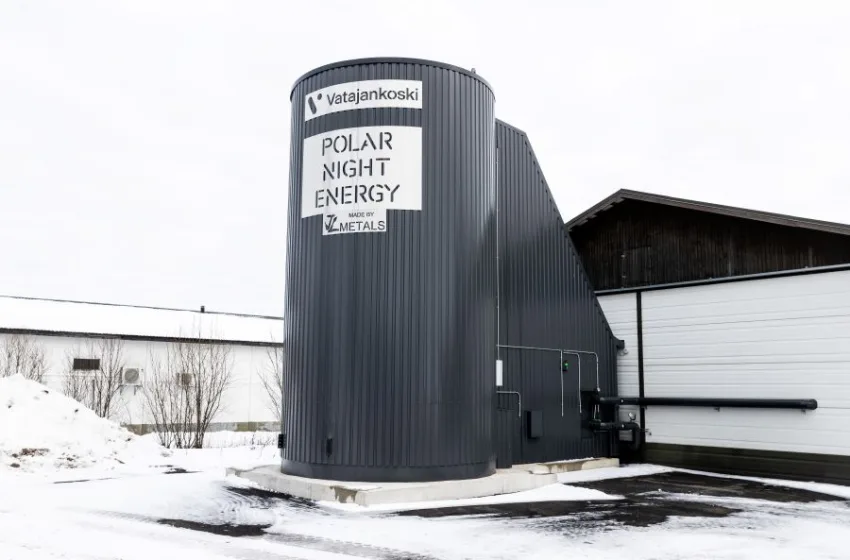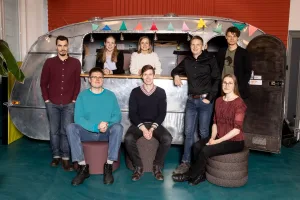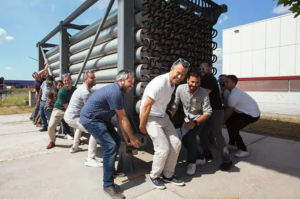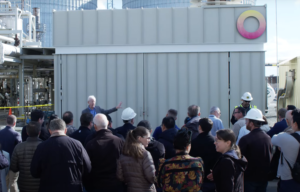Sand Batteries provide heat to district heating networks in Finland
March 6, 2024
Polar Night Energy is the only manufacturer with a solid-particle storage system among the companies of the survey with a commercial project. The company from Finland promotes its storage system under the brand name Sand Battery, as the vessel is filled with sand. The first commercial Sand Battery with 8 MWh has operated as part of the district heating grid of the utility company Vatajankoski in the town of Kankaanpää, Western Finland, since July 2022 (see photo). The steel container, which is 4 m wide and 7 m high, is filled with 100 tonnes of builder’s sand. Polar Night Energy was one of the 31 high-temperature storage solution providers that took part in a global survey in early 2024. You can find the results of the survey here.
Photo: Polar Night Energy
The storage system in Finland is part of the district heating network of the utility company Vatajankoski. Low-cost electricity heats the sand up to 500 °C using resistance heating via air. According to Polar Night there are no restrictions on the microscopic character and the mineral composition of the sand grains, so that waste sand from mining, for example, or builder’s sand could be used. The heat exchanger register inside the sand is used for both discharging and charging simultaneously (see scheme below).
“We began developing the Sand Battery technology in the 2010s, founded the company in 2018 and established a pilot plant with 3 MWh in the city of Tampere in 2020”, explained Matti Ulvinen, Product Sales Manager at Polar Night Energy. Here, the storage system was installed at a former pulp mill area, with the local council donating the work space and providing funding to get the project off the ground.

Young team of Finish startup Polar Night Energy, founded in 2018
Photo: Rami Marjamäki
“Currently, we’re focusing on projects in Finland and possibly in late 2024 we will expand our operations to supply and manufacture solutions in Europe”, Ulvinen added. Polar Night Energy is about to sign a turnkey delivery contract with another Finish district heating company for a Sand Battery with a maximum capacity of 100 MWh.
According to the company’s website the heat storage has its best range of use when it is charged and discharged 20 to 200 times per year, depending on the application. Based on the experience of operation at Vatajankoski and simulations, the company gives the annual efficiency of the small storage unit as 85 %. This efficiency considers an average of three-day cycles and defines the specifications, including those of the resistance heating and the air-water heat exchanger. “With larger systems above 100 MWh we aim at reaching annual efficiencies of 95 %”, said Ulvinen.
On the website it explains that the heat transfer pipe system inside the sand allows the prioritization of the outer layers when discharging the storage and the core when charging it. This is possible because a Sand Battery includes a network of several heat transfer pipes within the sand. As the heat conductivity of the sand is rather low, the outer parts of the storage act effectively as insulators for the core and thus there is always a considerably steep radial temperature profile inside the storage. Consequently, the outer layers of the sand-based heat storage have temperatures much below the average temperature of the system, which reduces the heat losses.

Scheme of the Sand Battery. The yellow coil on the left illustrates the resistance heater. The red-blue coil on the right shows the air-water heat exchanger with the pipes leading to the client. The air-filled piping system in the sand allows simultaneous charging and discharging. In this case the resistance heater is on, the sand is being heated up, but using the same circuit heat is being transferred via the air-water heat exchanger. Scheme: Polar Night Energy / Simo Heikkinen
| Storage tank provider | Polar Night Energy |
| Client name | Utility Vatajankoski, Finland |
| Name of storage | Sand Battery |
| Type of storage / storage material | Builder’s sand |
| Operation mode of storage | Power-to-heat |
| Maximum storage capacity | 8 MWh |
| Which application is the stored heat used for? | District heating energy |
| Heat transfer medium | Air for charging and discharging |
| Range of temperature for operating storage | 150 °C to 400 |
| Date of commissioning | July 2022 |
Key figures for the first commercial Sand Battery. A critical point in the table above is the maximum storage capacity information in megawatt hours. There is no standardized method to calculate the heat capacity of a high-temperature storage system and therefore numbers reported by each provider may be inconsistent or vary based on what calculation has been used. On this aspect, please also read the interview with storage expert Annelies Vandersickel.
You can find the data for 31 high-temperature storage solution providers in a tabular overview here.
Source: company’s information
Website of the organizations mentioned in this news article:
Polar Night Energy: https://polarnightenergy.fi/


